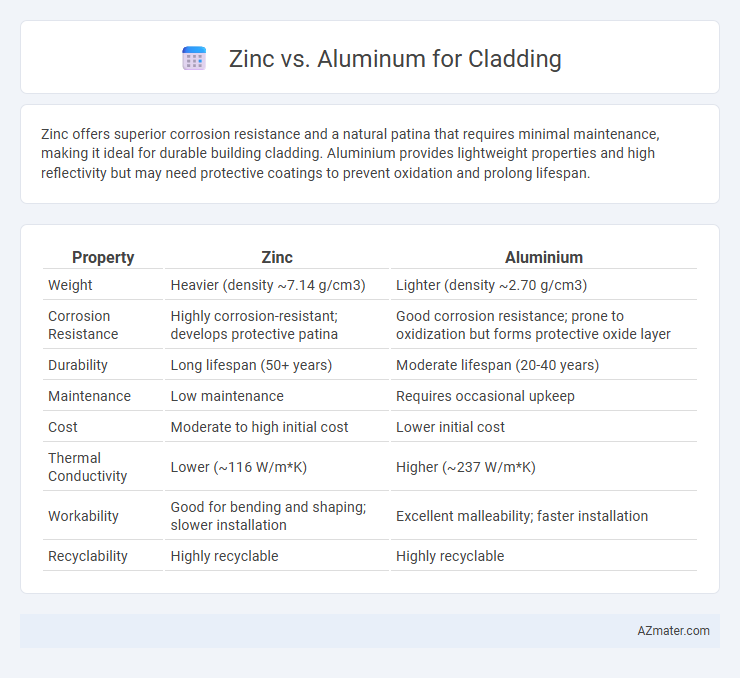Zinc offers superior corrosion resistance and a natural patina that requires minimal maintenance, making it ideal for durable building cladding. Aluminium provides lightweight properties and high reflectivity but may need protective coatings to prevent oxidation and prolong lifespan.
Table of Comparison
| Property | Zinc | Aluminium |
|---|---|---|
| Weight | Heavier (density ~7.14 g/cm3) | Lighter (density ~2.70 g/cm3) |
| Corrosion Resistance | Highly corrosion-resistant; develops protective patina | Good corrosion resistance; prone to oxidization but forms protective oxide layer |
| Durability | Long lifespan (50+ years) | Moderate lifespan (20-40 years) |
| Maintenance | Low maintenance | Requires occasional upkeep |
| Cost | Moderate to high initial cost | Lower initial cost |
| Thermal Conductivity | Lower (~116 W/m*K) | Higher (~237 W/m*K) |
| Workability | Good for bending and shaping; slower installation | Excellent malleability; faster installation |
| Recyclability | Highly recyclable | Highly recyclable |
Introduction to Cladding Materials
Zinc and aluminium are two prominent materials used for cladding, each offering distinct benefits in building facades. Zinc provides excellent durability, natural corrosion resistance, and a unique patina that enhances architectural aesthetics over time. Aluminium stands out for its lightweight nature, superior flexibility, and high reflectivity, making it ideal for energy-efficient cladding solutions.
Overview of Zinc Cladding
Zinc cladding offers exceptional durability, corrosion resistance, and low maintenance, making it ideal for modern architectural applications. It naturally forms a protective patina that self-heals scratches and enhances weather resistance over time. The lightweight and malleable properties of zinc allow for versatile design options, outperforming aluminium in longevity and environmental sustainability.
Overview of Aluminium Cladding
Aluminium cladding offers exceptional durability and corrosion resistance, making it ideal for exterior building facades in various climates. Its lightweight nature allows for easier installation and structural support compared to heavier materials like zinc. Aluminium also provides excellent thermal performance and is highly recyclable, contributing to sustainable building practices.
Key Differences Between Zinc and Aluminium
Zinc cladding offers superior corrosion resistance and a longer lifespan, often exceeding 80 years, while aluminium typically lasts around 40-60 years but provides better thermal conductivity and lighter weight. Zinc develops a protective patina that self-heals scratches, enhancing durability, whereas aluminium requires anodizing or coatings to prevent oxidation and maintain appearance. Cost-wise, aluminium is generally more affordable and easier to install due to its flexibility and lighter weight, making it suitable for complex architectural designs compared to zinc.
Durability and Longevity Comparison
Zinc cladding offers superior durability due to its natural resistance to corrosion and ability to develop a protective patina over time, extending its lifespan beyond 80 years in many environments. Aluminium cladding provides good resistance to rust but is more prone to denting and surface wear, generally lasting around 40 to 60 years with proper maintenance. Zinc's self-healing properties and low thermal expansion contribute to longer-lasting performance in harsh weather conditions compared to aluminium.
Aesthetic Qualities and Design Flexibility
Zinc offers a unique matte finish that develops a natural patina over time, enhancing its aesthetic appeal and providing an organic, evolving look ideal for modern and contemporary designs. Aluminium cladding provides a wider range of colors and finishes, including high-gloss and metallic options, enabling greater versatility in achieving precise architectural visions. Both materials are lightweight and malleable, but aluminium's superior formability allows for more intricate shapes and complex paneling systems in facade design.
Sustainability and Environmental Impact
Zinc cladding offers superior sustainability due to its 100% recyclability and low embodied energy, contributing to reduced lifecycle carbon emissions compared to aluminium. Aluminium cladding requires more energy-intensive extraction and processing, leading to higher initial environmental impact, though its recyclability also supports circular economy goals. Both materials provide durable, long-lasting solutions, but zinc's natural patina reduces maintenance needs, enhancing its eco-friendly profile over aluminium in sustainable construction.
Maintenance Requirements and Lifespan
Zinc cladding offers superior durability with a lifespan of up to 80-100 years and requires minimal maintenance due to its natural patina that protects against corrosion. Aluminium cladding, while lighter and easier to install, typically lasts 40-60 years and demands more frequent upkeep, including regular painting or anodizing to prevent oxidation and maintain appearance. Choosing zinc reduces long-term maintenance costs and extends the building envelope's integrity compared to aluminium.
Cost Considerations for Cladding Projects
Zinc cladding generally incurs higher upfront material and installation costs compared to aluminum, driven by zinc's weight and specialized handling requirements. Aluminum offers cost benefits due to its lighter weight, ease of fabrication, and lower labor expenses, making it a preferred choice for large-scale cladding projects where budget constraints are critical. Long-term maintenance costs for zinc are typically lower because of its natural patina formation, whereas aluminum may require more frequent upkeep and painting to retain appearance and performance.
Choosing the Right Material: Zinc vs Aluminium
Zinc offers exceptional durability and natural patination for cladding, making it ideal for long-term weather resistance and low maintenance in architectural applications. Aluminium provides lightweight properties with excellent corrosion resistance and a broader range of color finishes, suitable for designs requiring ease of installation and vibrant aesthetics. Selecting between zinc and aluminium cladding depends on structural requirements, environmental exposure, and desired visual impact, balancing longevity versus flexibility in design.

Infographic: Zinc vs Aluminium for Cladding
 azmater.com
azmater.com